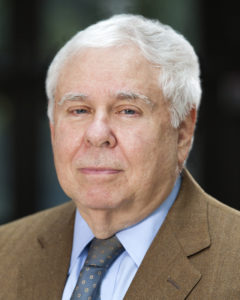Sanford Levinson’s Shame

At the University of Texas School of Law, on March 6, 2018 the student chapter of the Federalist Society sponsored a debate on the impact of race-based affirmative action on Asian-Americans. The speakers were noted UT law professor Sanford Levinson (defending racial and ethnic preferences) and Houston attorney Cory Liu, a volunteer with the organization Students for Fair Admissions, speaking in opposition. The speakers eloquently exchanged their views, before an attentive audience of over 100 persons, for nearly an hour, and then opened the discussion up to questions.

Defenders of racial and ethnic preferences, including UT in the Fisher case, argue that college admissions decisions must take race and ethnicity into account in order to produce the “right” mix of diversity, which they claim is essential to a university’s educational mission. Academic achievement (high school GPA and test scores) and other merit-based factors must be overridden, proponents of racial and ethnic preferences assert, in order to create an inclusive learning environment. Without the “correct” mix of diversity (meaning an adequate percentage of African-Americans and Hispanics, without too many Whites and Asian-Americans), UT would be unable to compete with other major schools and would lose ground in the national rankings.
This was the explanation endlessly repeated by UT’s lawyers and then-President William Powers during the Fisher case. “Diversity” is the “secret sauce” that supposedly makes otherwise-invalid racial and ethnic preferences defensible under Grutter v. Bollinger, 539 U.S. 306 (2003).

Accordingly, I asked Professor Levinson about California’s Proposition 209, passed in 1996, which banned the use of sex, race, or ethnicity in admissions at state-funded schools in California. By prohibiting such preferences, the University of California has moved towards a purely merit-based admissions policy. No demographic group is artificially helped or hindered in order to maintain an arbitrary quota in the student body. As a result, the most-selective campuses of UC—such as Berkeley, UCLA, and UC-San Diego–have become disproportionately Asian. Yet those schools have continued to be ranked among the best state universities in America, higher than UT–even with its vaunted “diversity.”
So my question to Professor Levinson was, how did he explain this outcome? Why does UC continue to outperform UT notwithstanding UC’s lack of “diversity”?

His response flabbergasted me. The entire videotape of the debate is linked here, but these are his words (at about the 0:56 mark): “I think that Texas has more to be ashamed about than California does in terms of its history with regard to both African-Americans and Mexican-Americans. We are the school of Sweatt vs. Painter. We were a slave state that seceded in order to preserve to slavery….California has a different history, and maybe it has less to apologize for.” (Emphasis added.)
Levinson inadvertently let the mask slip, and departed from UT’s carefully-crafted script in Fisher, returning to the discredited “reparations for past discrimination” rationale that the Fifth Circuit decisively rejected in Hopwood v. Texas, 78 F.3d 932, cert. denied, 578 U.S. 1033 (1996). This falls squarely into Michael Kinsley’s definition of a “gaffe”: Levinson uttered a truthful statement in public that he wasn’t supposed to say. Hopwood overturned UT’s regime of racial and ethnic preferences, concluding that race-based affirmative action was not justified as a remedy for past discrimination, yet that is exactly the excuse that Levinson offers.
The Fifth Circuit’s decision in Hopwood refutes Levinson’s explanation. For example, the court pointed out that “There is no history either of de jure discrimination against Mexican Americans in education at any level in Texas or of de facto discrimination against Mexican Americans by the law school.” Moreover,
While the school once did practice de jure discrimination in denying admission to blacks, the Court in Sweatt v. Painter, 339 U.S. 629 (1950), struck down the law school’s program. Any other discrimination by the law school ended in the 1960’s. Hopwood, 861 F. Supp. at 555. By the late 1960’s, the school had implemented its first program designed to recruit minorities, id. at 557, and it now engages in an extensive minority recruiting program that includes a significant amount of scholarship money. The vast majority of the faculty, staff, and students at the law school had absolutely nothing to do with any discrimination that the law school practiced in the past. In such a case, one cannot conclude that a hostile environment is the present effect of past discrimination. Any racial tension at the law school is most certainly the result of present societal discrimination and, if anything, is contributed to, rather than alleviated by, the overt and prevalent consideration of race in admissions. (Emphasis added.)
Levinson’s baseless insistence that historical grievances—dating back nearly 70 years, or even longer—justify UT’s current use of discriminatory preferences, recalls the Fifth Circuit’s admonition that “an inference is raised that the program was the result of racial social engineering rather a desire to implement a remedy.”

Professor Levinson, who has famously proposed that the United States scrap its Constitution because it is “imbecilic,” may be ashamed to be a Texan, but most residents of the Lone Star State are proud of their unique heritage. History is something to be remembered, and learned from, not atoned for. The notion that “Texas has more to be ashamed about than California,” or that “California has less to apologize for” than Texas, is simply insulting. If Professor Levinson is ashamed to live in Texas, he should move, not inflict his misguided sense of historical grievance on qualified applicants to UT, many of whom are unfairly rejected on racial or ethnic grounds to assuage Levinson’s peculiar liberal guilt.

If Texas wants to atone for state-sanctioned race discrimination—a “sin” it shares with much of the rest of the country, and which ended a half-century ago—it should stop discriminating against applicants to UT on the basis of race and ethnicity. Discrimination is wrong, period.
































